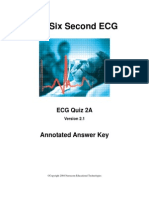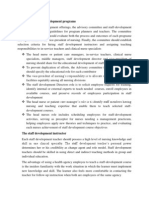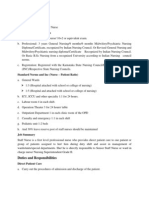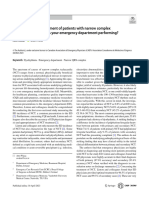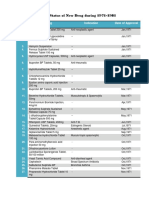Clinical Teaching Ecg Interpretation
Clinical Teaching Ecg Interpretation
Uploaded by
Anusha VergheseCopyright:
Available Formats
Clinical Teaching Ecg Interpretation
Clinical Teaching Ecg Interpretation
Uploaded by
Anusha VergheseOriginal Description:
Copyright
Available Formats
Share this document
Did you find this document useful?
Is this content inappropriate?
Copyright:
Available Formats
Clinical Teaching Ecg Interpretation
Clinical Teaching Ecg Interpretation
Uploaded by
Anusha VergheseCopyright:
Available Formats
Clinical teaching on ECG INTERPRETATION
Anatomy and Physiology of Cardiac Cycle:
BASICS OF ECG: The PQRST of Normal Sinus Rhythm
P WAVE - It represents atrial depolarization(electrical stimulation) and when it occurs on the EKG or strip we know that the atrial cells have received the stimulus from the SA Node.
PR INTERVAL: The PR interval measures the time it takes the impulse to travel from the atria to the ventricles.
QRS complex : It represents ventricular depolarization and when it occurs we know the ventricular cells have received the stimulus. It is measuring the time it takes the impulse to travel through the ventricles.
ST SEGMENT: an isolectric line following the QRS complex. It is telling us that the ventricles are repolarizing.
T WAVE: last wave form during a Normal sinus rhythm (NSR). When this occurs we know that the ventricles have recovered and are ready for the next impulse to occur.
The Cardiac Cycle Family :
1. The cardiac cycle family includes the P wave, QRS and ST segments and the T Wave 2. When the cardiac cycle is normal all of the waveforms (PQRST) will be present on the rhythm strip of EKG
3. All of these waveforms can be positive (above the isoelectric line), negative (below the isoelectric time) or biphasic (waveforms with components above and below the isoelectric line)
RECOGNIZING NORMAL SINUS RHYTHM ON AN EKG STRIP.
The EKG paper is divided into small squares and large squares. Each large square contais 25 small quares. 1. On the horizontal line, one small square represents .04 seconds and one large square represents .20 seconds in time 2. On the vertical line one small square represents 1 mm and one large square reoresebts 5mm in voltage. 3. 30 large squares equals 6 seconds in time. When calculating time for the different waves, segments and complexes you count the amount of small squares and multiply by o.4 4. When calculating the heart rate., you are also counting the ventricular rate: count the number of squares inbetween the two spikes of the QRS complex.. 5. 30 large squares equal 6 second strips. You can calculate the HR by counting how many QRS complexes there are in a six second time frame and multiplying by ten.
Normal Sinus Rhytm Requirements : 1. Ventricular Rate: 60-100bpm 2. Ventricular Rhythm: Regular 3. Ventricular rhythm is determined by measuring the R-R interval. The R-R interval is the dcistance between 2 QRS complexes 4. PWAVES: P waves should be present, a P wave for ever QRS and the configuration normal for eh lead. P waves should be upright in Lead II and the can be upright, biphasic or inverted in Lead V1 (rhythm strips on telemetry floors and the bottom of the 12 lead ekg, are lead II) 5. Atrial Rate : 60- 100 6. Count how many boxes inbetween the p waves. Or , on a second strip count how many p waves and multiply by 10.
Normal Sinus Rhytm Requirements :
1. Atrial Rhythm is determined by measuring the P-P interval . They should be the same distance between on each measured. A variation of 0.12 seconds (3 small squares) can occur and the rhythm is considered regular. 2. PR Interval: The PR interval measures the time it takes the impulse to travel from the atria to the ventricles. 3. QRS: The QRS duration measures the time it takes the impulse to travel through the ventricles. 4. Twaves should all have the same configuration. Twaves have a wealth of information in them and is important to study, they are almost the most unstable component of an EKG. A different T wave configuration does not always mean something is going on.
NORMAL SINUS RHYTHM BY THE NUMBERS
ABNORMALITIES THAT CAN BE DIAGNOSED WITH EKG Shortened QT interval 1. Hyperkalemia, 2. some drugs, 3. certain genetic abnormalities Prolonged QT interval: 1. Hypokalemia 2. some drugs 3. certain gentic abnormalities Flattened or Inverted T waves 1. Coronary Ischemia, 2. hypokalemia, 3. Left Ventricular hypertropy 4. Digoxin effect 5. some drugs. Hyperacute T Waves 1. 1st sign of acute MI, where T waves become more prominent, symmetrical and pointed PVCs present: Low Magnesium Peaked Twaves, widened QRS complex, Depressed ST Hyperkalemia Flattened T waves, Prominent U WAVES Hypokalemia
ARRYTHMIA /DYSRYTHMIA
Sinus Bradycardia
A heart rate less than 60 beats per minute (BPM). This in a healthy athletic person may be 'normal', but other causes may be due to increased vagal tone from drug abuse, hypoglycaemia and brain injury with increase intracranial pressure (ICP) as examples
Looking at the ECG you'll see that: Rhythm - Regular Rate - less than 60 beats per minute QRS Duration - Normal P Wave - Visible before each QRS complex P-R Interval - Normal Usually benign and often caused by patients on beta blockers
SINUS TACHYCARDIA
An excessive heart rate above 100 beats per minute (BPM) which originates from the SA node. Causes include stress, fright, illness and exercise. Not usually a surprise if it is triggered in response to regulatory changes e.g. shock. But if their is no apparent trigger then medications may be required to suppress the rhythm Looking at the ECG you'll see that: Rhythm - Regular Rate - More than 100 beats per minute QRS Duration - Normal P Wave - Visible before each QRS complex P-R Interval - Normal The impulse generating the heart beats are normal, but they are occurring at a faster pace than normal. Seen during exercise
Supraventricular Tachycardia (SVT) Abnormal
1. A narrow complex tachycardia or atrial tachycardia which originates in the 'atria' but is not under direct control from the SA node. SVT can occur in all age groups 2. Looking at the ECG you'll see that: 3. Rhythm - Regular 4. Rate - 140-220 beats per minute 5. QRS Duration - Usually normal 6. P Wave - Often buried in preceding T wave 7. P-R Interval - Depends on site of supraventricular pacemaker 8. Impulses stimulating the heart are not being generated by the sinus node, but instead are coming from a collection of tissue around and involving the atrioventricular (AV) node
Atrial Fibrillation
1. Many sites within the atria are generating their own electrical impulses, leading to irregular conduction of impulses to the ventricles that generate the heartbeat. This irregular rhythm can be felt when palpating a pulse 2. Looking at the ECG you'll see that: 3. Rhythm - Irregularly irregular Rate - usually 100-160 beats per minute but slower if on medication QRS Duration - Usually normal P Wave - Not distinguishable as the atria are firing off all over P-R Interval - Not measurable The atria fire electrical impulses in an irregular fashion causing irregular heart rhythm Fibrillation 4. Many sites within the atria are generating their own electrical impulses, leading to irregular conduction of impulses to the ventricles that generate the heartbeat. This irregular rhythm can be felt when palpating a pulse 5. Looking at the ECG you'll see that: 6. Rhythm - Irregularly irregular Rate - usually 100-160 beats per minute but slower if on medication QRS Duration - Usually normal P Wave - Not distinguishable as the atria are firing off all over P-R Interval - Not measurable The atria fire electrical impulses in an irregular fashion causing irregular heart rhythm
Atrial Flutter
1. Looking at the ECG you'll see that: 2. Rhythm - Regular Rate - Around 110 beats per minute QRS Duration Usually normal P Wave - Replaced with multiple F (flutter) waves, usually at a ratio of 2:1 (2F - 1QRS) but sometimes 3:1 P Wave rate - 300 beats per minute P-R Interval - Not measurable As with SVT the abnormal tissue generating the rapid heart rate is also in the atria, however, the atrioventricular node is not involved in this case.
1st Degree AV Block
1. 1st Degree AV block is caused by a conduction delay through the AV node but all electrical signals reach the ventricles. This rarely causes any problems by itself and often trained athletes can be seen to have it. The normal P-R interval is between 0.12s to 0.20s in length, or 3-5 small squares on the ECG. 2. Looking at the ECG you'll see that: 3. Rhythm - Regular Rate - Normal QRS Duration - Normal P Wave - Ratio 1:1 P Wave rate - Normal P-R Interval - Prolonged (>5 small squares)
2nd Degree Block Type 1 (Wenckebach)
1. Another condition whereby a conduction block of some, but not all atrial beats getting through to the ventricles. There is progressive lengthening of the PR interval and then failure of conduction of an atrial beat, this is seen by a dropped QRS complex. 2. Looking at the ECG you'll see that: 3. Rhythm - Regularly irregular Rate - Normal or Slow QRS Duration Normal P Wave - Ratio 1:1 for 2,3 or 4 cycles then 1:0. P Wave rate Normal but faster than QRS rate P-R Interval - Progressive lengthening of PR interval until a QRS complex is dropped
2nd Degree Block Type 2
1. When electrical excitation sometimes fails to pass through the A-V node or bundle of His, this intermittent occurance is said to be called second degree heart block. Electrical conduction usually has a constant P-R interval, in the case of type 2 block atrial contractions are not regularly followed by ventricular contraction
2. Looking at the ECG you'll see that: 3. Rhythm - Regular Rate - Normal or Slow QRS Duration - Prolonged P Wave - Ratio 2:1, 3:1 P Wave rate - Normal but faster than QRS rate P-R Interval - Normal or prolonged but constant
3rd Degree Block
1. 3rd degree block or complete heart block occurs when atrial contractions are 'normal' but no electrical conduction is conveyed to the ventricles. The ventricles then generate their own signal through an 'escape mechanism' from a focus somewhere within the ventricle. The ventricular escape beats are usually 'slow' 2. Looking at the ECG you'll see that: 3. Rhythm - Regular Rate - Slow QRS Duration - Prolonged P Wave Unrelated P Wave rate - Normal but faster than QRS rate P-R Interval Variation Complete AV block. No atrial impulses pass through the atrioventricular node and the ventricles generate their own rhythm
Bundle Branch Block
Abnormal conduction through the bundle branches will cause a depolarization delay through the ventricular muscle, this delay shows as a widening of the QRS complex. Right Bundle Branch Block (RBBB) indicates problems in the right side of the heart. Whereas Left Bundle Branch Block (LBBB) is an indication of heart disease. If LBBB is present then further interpretation of the ECG cannot be carried out. Looking at the ECG you'll see that: Rhythm - Regular Rate - Normal QRS Duration - Prolonged P Wave - Ratio 1:1 P Wave rate - Normal and same as QRS rate P-R Interval - Normal
Premature Ventricular Complexes
Due to a part of the heart depolarizing earlier than it should Looking at the ECG you'll see that: Rhythm - Regular Rate - Normal QRS Duration - Normal P Wave - Ratio 1:1 P Wave rate - Normal and same as QRS rate P-R Interval - Normal Also you'll see 2 odd waveforms, these are the ventricles depolarising prematurely in response to a
signal within the ventricles.(Above - unifocal PVC's as they look alike if they differed in appearance they would be called multifocal PVC's, as below)
Junctional Rhythms
Looking at the ECG you'll see that: Rhythm - Regular Rate - 40-60 Beats per minute QRS Duration - Normal P Wave - Ratio 1:1 if visible. Inverted in lead II P Wave rate - Same as QRS rate P-R Interval - Variable Below - Accelerated Junctional Rhythm
Ventricular Tachycardia (VT) Abnormal
1. Looking at the ECG you'll see that: 2. Rhythm - Regular Rate - 180-190 Beats per minute QRS Duration Prolonged P Wave - Not seen Results from abnormal tissues in the ventricles
generating a rapid and irregular heart rhythm. Poor cardiac output is usually associated with this rhythm thus causing the pt to go into cardiac arrest. Shock this rhythm if the patient is unconscious and without a pulse
Ventricular Fibrillation (VF) Abnormal
Disorganised electrical signals cause the ventricles to quiver instead of contract in a rhythmic fashion. A patient will be unconscious as blood is not pumped to the brain. Immediate treatment by defibrillation is indicated. This condition may occur during or after a myocardial infarct. Looking at the ECG you'll see that: Rhythm - Irregular Rate - 300+, disorganised QRS Duration - Not recognisable P Wave - Not seen This patient needs to be defibrillated!! QUICKLY
Asystole - Abnormal
1. Looking at the ECG you'll see that:
2. Rhythm - Flat Rate - 0 Beats per minute QRS Duration - None P Wave None 3. Carry out CPR!!
Myocardial Infarct (MI)
Looking at the ECG you'll see that: Rhythm - Regular Rate - 80 Beats per minute QRS Duration - Normal P Wave Normal S-T Element does not go isoelectric which indicates infarction
LABORATORY TESTS CMP Look for electrolyte imbalances. Particularly look for K+ Pre cath look at renal functioning due to dye. Magnesium level CBC Complete blood count, Focus on hemoglobin and hematocrit BNP High levels are an indicator for congestive heart failure
PT/INR especially if patient is on anticoagulation therapy
SCREENING CARDIAC PANEL TROPONIN High specificity for myocardial cell injurty, cardiac troponin and cardiac troponin1 helpful in evaluation of patients with chest pain More specific for cardiac injury than CPK-MB Elevation sooner and remain elevated longer than CPK-MB Allows longer time for Dx and thrombolytic tx of MI. Used for differentiating cardiac from non cardiac chest pain Evaluation of patients with unstable angina Estimate the size of the MI Detect preop MI
SCREENING CARDIAC PANEL CPK-MB ( creatine phosphokinase) Specific for myocardial cells Levels rise three to six hours after damage If damage is not persistent the levels peak at 18 hours post damage Returns to normal after two to three days
Cardiac panels are usually done in serial draws. Usually q 8hrs, or q4/12/24hrs. After admit. DIAGNOSTIC TESTS 1. EKG 2. ECHOCARDIOGRAM 3. STRESS ECHO 4. TILT TABLE TEST 5. CARDIAC CATHERIZATION 6. ELECTROPHYSIOLOGY TEST 7. CT HEART SCAN 8. MYOCARDIAL BIOPSY 9. HEART MRI 10.PERICARDIOCENTESIS
ECG/EKG PROCEDURE ECG Basics The electrocardiogram (ECG) is a diagnostic tool that measures and records the electrical activity of the heart in detail. Being able to interpretate these details allows diagnosis of a wide range of heart problems. ECG Electrodes Skin Preparation: Clean with an alcohol wipe if necessary. If the patients are very hairy shave the electrode areas. ECG standard leads
There are three of these leads, I, II and III. Lead I: is between the right arm and left arm electrodes, the left arm being positive. Lead II: is between the right arm and left leg electrodes, the left leg being positive. Lead III: is between the left arm and left leg electrodes, the left leg again being positive. Chest Electrode Placement V1: Fourth intercostal space to the right of the sternum. V2: Fourth intercostal space to the Left of the sternum. V3: Directly between leads V2 and V4. V4: Fifth intercostal space at midclavicular line. V5: Level with V4 at left anterior axillary line. V6: Level with V5 at left midaxillary line. (Directly under the midpoint of the armpit)
LEAD PLACEMENT ILLUSTRATIONS
A little More Info about EKG: Chest Leads V1 & V2 V3 & V4 V5 & V6 View Right Ventricle Septum/Lateral Left Ventricle Anterior/Lateral Left Ventricle
Atrial contractions show up as the P wave. Ventricular contractions show as a series known as the QRS complex. The third and last common wave in an ECG is the T wave. This is the electrical activity produced when the ventricles are recharging for the next contraction (repolarizing). Interestingly, the letters P, Q, R, S, and T are not abbreviations for any actual words but were chosen many years ago for their position in the middle of the alphabet. The electrical activity results in P, QRS, and T waves that are of different sizes and shapes. When viewed from different leads, these waves can show a wide range of abnormalities of both the electrical conduction system and the muscle tissue of the hearts 4 pumping chambers. CONCLUSION So far we have discussed on the anatomy and physiology of the heart , basics of Ecg , Arrthymias Nurses play and important role in identification of abnormal ecg rhythms .Thereby to provide prompt interventions in treating patients
You might also like
- EKG | ECG Interpretation. Everything You Need to Know about 12-Lead ECG/EKG InterpretationFrom EverandEKG | ECG Interpretation. Everything You Need to Know about 12-Lead ECG/EKG InterpretationRating: 3 out of 5 stars3/5 (1)
- Senior Staff Nurse Job DescriptionDocument2 pagesSenior Staff Nurse Job DescriptionAnusha Verghese70% (10)
- Rapid Interpretation of EKG's 6th EdDocument14 pagesRapid Interpretation of EKG's 6th EdDenise De Los Reyes100% (3)
- Electrocardiography (ECG) Recording and InterpretationDocument59 pagesElectrocardiography (ECG) Recording and Interpretationkhushsandhu0% (1)
- The 12-Lead Electrocardiogram for Nurses and Allied ProfessionalsFrom EverandThe 12-Lead Electrocardiogram for Nurses and Allied ProfessionalsNo ratings yet
- ECG AbnormalitiesDocument9 pagesECG Abnormalitiesbigabm062No ratings yet
- EKG | ECG: An Ultimate Step-By-Step Guide to 12-Lead EKG | ECG Interpretation, Rhythms & Arrhythmias Including Basic Cardiac DysrhythmiasFrom EverandEKG | ECG: An Ultimate Step-By-Step Guide to 12-Lead EKG | ECG Interpretation, Rhythms & Arrhythmias Including Basic Cardiac DysrhythmiasRating: 3 out of 5 stars3/5 (5)
- Cardiac Surgeries: and ManagementDocument64 pagesCardiac Surgeries: and ManagementSimon Josan50% (2)
- Arterial Lines MonitoringDocument13 pagesArterial Lines MonitoringJoseph Beredo33% (3)
- Types of Staff DevelopmentDocument2 pagesTypes of Staff DevelopmentAnusha Verghese86% (7)
- Types of Staff DevelopmentDocument2 pagesTypes of Staff DevelopmentAnusha Verghese86% (7)
- Joint Director of NursingDocument2 pagesJoint Director of NursingAnusha VergheseNo ratings yet
- ECG .DR Ayalew EthiopiaDocument60 pagesECG .DR Ayalew EthiopiaAyalew Zewdie100% (2)
- Clinical TerminologyDocument10 pagesClinical TerminologyLourrany BorgesNo ratings yet
- Abnormal ECG 1Document26 pagesAbnormal ECG 1Apriliani Nur Puspita SariNo ratings yet
- Basics of EcgDocument58 pagesBasics of Ecgbtalera100% (4)
- ECG InterpretationDocument11 pagesECG InterpretationAndrea AndradaNo ratings yet
- Kuliah Ekg UnswagatiDocument75 pagesKuliah Ekg UnswagatiiikNo ratings yet
- ECG & EKG Interpretation: How to interpret ECG & EKG, including rhythms, arrhythmias, and more!From EverandECG & EKG Interpretation: How to interpret ECG & EKG, including rhythms, arrhythmias, and more!No ratings yet
- EKG and ECG Interpretation: Learn EKG Interpretation, Rhythms, and Arrhythmia Fast!From EverandEKG and ECG Interpretation: Learn EKG Interpretation, Rhythms, and Arrhythmia Fast!No ratings yet
- EKG Interpretation Basics Guide: Electrocardiogram Heart Rate Determination, Arrhythmia, Cardiac Dysrhythmia, Heart Block Causes, Symptoms, Identification and Medical Treatment Nursing HandbookFrom EverandEKG Interpretation Basics Guide: Electrocardiogram Heart Rate Determination, Arrhythmia, Cardiac Dysrhythmia, Heart Block Causes, Symptoms, Identification and Medical Treatment Nursing HandbookNo ratings yet
- Perfusion for Congenital Heart Surgery: Notes on Cardiopulmonary Bypass for a Complex Patient PopulationFrom EverandPerfusion for Congenital Heart Surgery: Notes on Cardiopulmonary Bypass for a Complex Patient PopulationRating: 5 out of 5 stars5/5 (2)
- Heart Block, A Simple Guide To The Condition, Diagnosis, Treatment And Related ConditionsFrom EverandHeart Block, A Simple Guide To The Condition, Diagnosis, Treatment And Related ConditionsNo ratings yet
- Torsade De Pointes, A Simple Guide To The Condition, Diagnosis, Treatment And Related ConditionsFrom EverandTorsade De Pointes, A Simple Guide To The Condition, Diagnosis, Treatment And Related ConditionsNo ratings yet
- The Six Second ECG: Annotated Answer KeyDocument9 pagesThe Six Second ECG: Annotated Answer KeyShimika Tomes100% (1)
- 5 ECG Interpretation With AnswersDocument48 pages5 ECG Interpretation With AnswersQusai Ibraheem100% (1)
- Chest X - Ray InterpretationDocument147 pagesChest X - Ray InterpretationFcsieka FcseikaNo ratings yet
- Unit 6 Cardiac Catheterization and AngiographyDocument28 pagesUnit 6 Cardiac Catheterization and AngiographyJack Tomar100% (1)
- ECG Interpretation: DR S J Bhosale DM, FPCC (Canada) Associate Professor Tata Memorial CentreDocument90 pagesECG Interpretation: DR S J Bhosale DM, FPCC (Canada) Associate Professor Tata Memorial Centrevaishali TayadeNo ratings yet
- Critical Care NursingDocument1 pageCritical Care NursingMelissa David0% (1)
- Cardiac Stress TestDocument32 pagesCardiac Stress Testarahman168100% (1)
- Adult Cardiac Surgery - Nursing Care and ManagementDocument225 pagesAdult Cardiac Surgery - Nursing Care and ManagementOsama Elsayed AhmedNo ratings yet
- Defibrillation and Cardioversion PDFDocument12 pagesDefibrillation and Cardioversion PDFmadeNo ratings yet
- ECG For BeginnersDocument61 pagesECG For Beginnersblndffl100% (3)
- How To Read An ECGDocument21 pagesHow To Read An ECGSlychenko100% (2)
- Ecg 1Document40 pagesEcg 1doctorhanifNo ratings yet
- Arterial LinesDocument13 pagesArterial LinesberhanubedassaNo ratings yet
- Basic EKG Dysrhythmia IdentificationDocument40 pagesBasic EKG Dysrhythmia IdentificationIlda Dhe Devis Spaho100% (1)
- Ecg Interpretation: Presented by:-ROHINI RAI M SC Nursing Part I, C.O.N, N.B.M.C.HDocument69 pagesEcg Interpretation: Presented by:-ROHINI RAI M SC Nursing Part I, C.O.N, N.B.M.C.HRohini RaiNo ratings yet
- Joseph Brian L. Costiniano, MD, DPCPDocument70 pagesJoseph Brian L. Costiniano, MD, DPCPcarmsNo ratings yet
- Speaker: Maj YS Swapna Sudha Chair Person: Maj Swapna Dharmaji Moderator: Col S.SenguptaDocument33 pagesSpeaker: Maj YS Swapna Sudha Chair Person: Maj Swapna Dharmaji Moderator: Col S.SenguptaSudha Kiran100% (1)
- Cardiac Rhythms - ECG ReadingsDocument15 pagesCardiac Rhythms - ECG Readingsal-obinay shereen100% (1)
- PacemakerDocument48 pagesPacemakersoniya josephNo ratings yet
- Cardiac Catheterization and Coronary AngiographyDocument5 pagesCardiac Catheterization and Coronary Angiographyedem100% (1)
- Intra Aortic Balloon Pump (IABP) BasicsDocument35 pagesIntra Aortic Balloon Pump (IABP) BasicsvamshidhNo ratings yet
- Pacemaker Invasive Cardiac PacingDocument57 pagesPacemaker Invasive Cardiac PacingAhmad Khalil Ahmad Al-SadiNo ratings yet
- Basic ArrythmiasDocument58 pagesBasic ArrythmiasZachary Cohen100% (2)
- CardiacDocument18 pagesCardiacAya Mohamed100% (1)
- Hemodynamic MonitoringDocument25 pagesHemodynamic MonitoringMichelle Chu100% (2)
- Holter MonitoringDocument19 pagesHolter Monitoringomotola Ayobundle-oyewo MA206100% (2)
- Mitral Stenosis PresentationDocument84 pagesMitral Stenosis PresentationStawan Chougule100% (2)
- Arrhythmia ReviewDocument33 pagesArrhythmia ReviewMark Hammerschmidt100% (3)
- Electrocardiogram (E.C.G)Document51 pagesElectrocardiogram (E.C.G)Jamuna PatelNo ratings yet
- Cardiac DysrhythmiasDocument6 pagesCardiac DysrhythmiasJeffrey Viernes100% (1)
- LS Identifying ArrhythmiasDocument5 pagesLS Identifying ArrhythmiasClaudia Park100% (1)
- IV PDFDocument63 pagesIV PDFelbagouryNo ratings yet
- Arterial Lines in PACU: Presented by Autum Jacobs RN, BSNDocument34 pagesArterial Lines in PACU: Presented by Autum Jacobs RN, BSNinuko1212No ratings yet
- Cardiac Catheterization and MonitoringDocument40 pagesCardiac Catheterization and MonitoringMarissa Asim100% (1)
- ECG Made Easy For Allied Health ProfessionalsDocument47 pagesECG Made Easy For Allied Health ProfessionalsDr GowrishankarPotturi PT100% (3)
- Chronic Kidney Disease-Mineral Bone DisorderDocument49 pagesChronic Kidney Disease-Mineral Bone DisorderÀi ZìjǐNo ratings yet
- ECG (Rythm Interpretation)Document39 pagesECG (Rythm Interpretation)RatnaSuryati100% (1)
- ECG Fast and EasyDocument37 pagesECG Fast and EasyKofi Ziggy100% (2)
- Valve SurgeriesDocument13 pagesValve SurgeriesShreeja SajitNo ratings yet
- Basic Life Support (BLS) and Advanced Cardiovascular Life Support (ACLS)Document35 pagesBasic Life Support (BLS) and Advanced Cardiovascular Life Support (ACLS)rajNo ratings yet
- Cardiac CathDocument5 pagesCardiac CathNader Smadi50% (2)
- GerentologyDocument17 pagesGerentologyAnusha Verghese100% (1)
- Conceptual Frame WorkDocument36 pagesConceptual Frame WorkAnusha VergheseNo ratings yet
- Principles For Successful Staff DevelopmentDocument3 pagesPrinciples For Successful Staff DevelopmentAnusha VergheseNo ratings yet
- Physiology of NewbornDocument3 pagesPhysiology of NewbornAnusha VergheseNo ratings yet
- Public RelationsDocument5 pagesPublic RelationsAnusha Verghese100% (2)
- Principles For Successful Staff DevelopmentDocument3 pagesPrinciples For Successful Staff DevelopmentAnusha VergheseNo ratings yet
- Methods of Public RelationsDocument3 pagesMethods of Public RelationsAnusha Verghese100% (2)
- Occupational Health and SafetyDocument8 pagesOccupational Health and SafetyAnusha VergheseNo ratings yet
- Roles and Functions of Administrator in Staff DevelopmentDocument2 pagesRoles and Functions of Administrator in Staff DevelopmentAnusha Verghese100% (1)
- Staff DevelopmentDocument3 pagesStaff DevelopmentAnusha Verghese100% (2)
- Guidelines For Staff-Development ProgramsDocument2 pagesGuidelines For Staff-Development ProgramsAnusha VergheseNo ratings yet
- Public RelationsDocument5 pagesPublic RelationsAnusha Verghese100% (2)
- Public Relation in HospitalDocument6 pagesPublic Relation in HospitalAnusha Verghese80% (5)
- Group DynamicsDocument10 pagesGroup DynamicsAnusha VergheseNo ratings yet
- Organization of HospitalDocument29 pagesOrganization of HospitalAnusha VergheseNo ratings yet
- PrincipalDocument3 pagesPrincipalAnusha VergheseNo ratings yet
- Assistant Professor Nursing CollegeDocument3 pagesAssistant Professor Nursing CollegeAnusha Verghese100% (1)
- Nursing Superintendent Grade IDocument2 pagesNursing Superintendent Grade IAnusha VergheseNo ratings yet
- Nursing Tutor and Clinical InstructorsDocument2 pagesNursing Tutor and Clinical InstructorsAnusha Verghese100% (2)
- Nursing Superintendent Grade IIDocument2 pagesNursing Superintendent Grade IIAnusha Verghese100% (2)
- Professor CollegeDocument3 pagesProfessor CollegeAnusha VergheseNo ratings yet
- Public Health NurseDocument2 pagesPublic Health NurseAnusha VergheseNo ratings yet
- Staff Nurse Job DescriptionDocument4 pagesStaff Nurse Job DescriptionAnusha VergheseNo ratings yet
- Ved AnalysisDocument2 pagesVed AnalysisAnusha VergheseNo ratings yet
- Principal CollegeDocument4 pagesPrincipal CollegeAnusha Verghese67% (3)
- Consumer ActDocument13 pagesConsumer ActAnusha VergheseNo ratings yet
- Tachyarrhythmia SDocument46 pagesTachyarrhythmia SAsif HameedNo ratings yet
- 1 PBDocument3 pages1 PBJovie MasongsongNo ratings yet
- The Vanish TrialDocument41 pagesThe Vanish TrialSilp SatjawattanavimolNo ratings yet
- Cardiac QuestionsDocument13 pagesCardiac Questionsacque100% (1)
- NCM 118 Lec MidtermDocument43 pagesNCM 118 Lec MidtermakiNo ratings yet
- Medications Used in Code Blue EmergenciesDocument24 pagesMedications Used in Code Blue EmergenciesAhmed Ali Mohammed AlbashirNo ratings yet
- Test 2Document7 pagesTest 2Rahmat RamadhanNo ratings yet
- Northern Health - 19 July 2016 PDFDocument4 pagesNorthern Health - 19 July 2016 PDFTimes MediaNo ratings yet
- Normal Varient ECGDocument64 pagesNormal Varient ECGShah NahidNo ratings yet
- Temporary PacemakerDocument35 pagesTemporary Pacemakerromeorobin07No ratings yet
- Epatch Brochure NEW MAR2023 220 0730 01 Rev. E 9.20.23Document8 pagesEpatch Brochure NEW MAR2023 220 0730 01 Rev. E 9.20.23yfrywbc57sNo ratings yet
- Little Piano Etudes - CompDocument3 pagesLittle Piano Etudes - CompAlbertoNo ratings yet
- Skill ArytmiaDocument71 pagesSkill ArytmiaDikie MustofadijayaNo ratings yet
- Wolff-Parkinson-White Syndrome: Anatomy, Epidemiology, Clinical Manifestations, and Diagnosis - UpToDateDocument46 pagesWolff-Parkinson-White Syndrome: Anatomy, Epidemiology, Clinical Manifestations, and Diagnosis - UpToDateKarla ChongNo ratings yet
- Abel Wakai Diagnosis and Management of Patients WithDocument2 pagesAbel Wakai Diagnosis and Management of Patients WithJuliaNo ratings yet
- Cardiac Toxic ResponsesDocument10 pagesCardiac Toxic ResponsesDaismar ArenasNo ratings yet
- ECG InterpretationDocument81 pagesECG Interpretationd.ramadhan100% (5)
- CG B Ook: Rapid FindDocument25 pagesCG B Ook: Rapid FinddellaNo ratings yet
- DR K Chan - Ecg For SVT Made EasyDocument66 pagesDR K Chan - Ecg For SVT Made Easyapi-346486620No ratings yet
- Approval Status of New Drug During 1971-1981Document44 pagesApproval Status of New Drug During 1971-1981garvit kumarNo ratings yet
- Cardiac Dysrhythmias ExamDocument4 pagesCardiac Dysrhythmias Exambobtaguba100% (3)
- Mi (Case # 1) : 1. How Would You Classify Mr. Smith's Chest Pain?Document11 pagesMi (Case # 1) : 1. How Would You Classify Mr. Smith's Chest Pain?Faizan MazharNo ratings yet
- Dysrhythmias 1: Cardiac Conduc1on System Rhythm Strip Recogni1onDocument4 pagesDysrhythmias 1: Cardiac Conduc1on System Rhythm Strip Recogni1ontantalizin marieNo ratings yet
- Rhythm P Wave PR Interval QRS Rate Regularity Life Threatening CausesDocument3 pagesRhythm P Wave PR Interval QRS Rate Regularity Life Threatening CausesLedio XhezairiNo ratings yet




























